Get free scan and check if your device is infected.
Remove it nowTo use full-featured product, you have to purchase a license for Combo Cleaner. Seven days free trial available. Combo Cleaner is owned and operated by RCS LT, the parent company of PCRisk.com.
What are fake "LinkedIn" emails?
"LinkedIn email scam" refers to spam campaigns - large-scale operations during which thousands of emails presented as messages from LinkedIn are sent. LinkedIn is a business and employment-oriented online service, designed to aid in professional networking.
The aim of the fake "LinkedIn" emails is to steal users' LinkedIn and/or email accounts. This is achieved via promotion of phishing websites that are disguised as sign-in pages.
Log-in credentials (e.g., email addresses, usernames, and passwords) entered into such sites are exposed to scammers, who can then use them to gain access/control over the corresponding accounts.
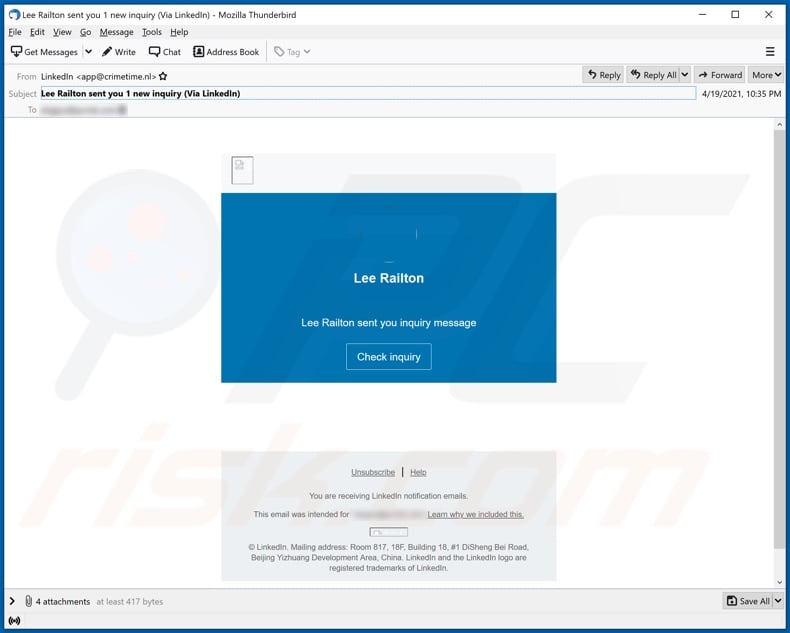
More about fake "LinkedIn" emails
The fraudulent "LinkedIn" emails can wear a variety of disguises and concern different topics. These letters promote phishing websites through links presented in them or attached files that lead to said pages.
For example, scam emails with the title/subject "Lee Railton sent you 1 new inquiry (Via LinkedIn)" are disguised as notifications, which alert recipients that they have an unread inquiry message. The researched letters endorsed phishing sites through links (buttons) and file attachments.
The fake "LinkedIn" website pushed via this email variant was hosted on Weebly (a legitimate web hosting service) and requested users to sign in using their email account credentials. To avoid having LinkedIn, email, or other online accounts stolen, it is strongly advised to exercise caution with incoming emails.
It is recommended to pay attention to the senders' email addresses, contents of the letters, and sign-in webpage URLs. Should attempts to log in via a phishing website have already been made - the accounts' passwords must be changed immediately.
Additionally, the official support of the potentially compromised platforms should be contacted without delay. To elaborate on how scammers can use hijacked communication-related platforms (e.g., professional networking [LinkedIn], social media, email, messengers, etc.) - they can pretend to be the account's genuine owner and ask contacts/friends for loans.
Alternatively, these platforms can be used to spread malware by sharing infectious files or links to malicious websites. Email accounts are of particular interest to scammers as they are typically connected to other platforms and services.
Hence, via stolen emails - access/control may be gained over content associated with them. In addition to communication-oriented accounts, finance-related ones are often registered through emails as well.
Banking, money transferring, e-commerce, digital wallet, and similar accounts can be used by scammers to make fraudulent transactions and/or online purchases. To summarize, by trusting fake "LinkedIn" emails, users can experience severe privacy issues, financial losses, identity theft, and system infections.
| Name | LinkedIn Email Scam |
| Threat Type | Phishing, Scam, Social Engineering, Fraud |
| Disguise | Scam emails are presented as mail from LinkedIn |
| Symptoms | Unauthorized online purchases, changed online account passwords, identity theft, illegal access of the computer. |
| Distribution methods | Deceptive emails, rogue online pop-up ads, search engine poisoning techniques, misspelled domains. |
| Damage | Loss of sensitive private information, monetary loss, identity theft. |
| Malware Removal (Windows) |
To eliminate possible malware infections, scan your computer with legitimate antivirus software. Our security researchers recommend using Combo Cleaner. Download Combo CleanerTo use full-featured product, you have to purchase a license for Combo Cleaner. 7 days free trial available. Combo Cleaner is owned and operated by RCS LT, the parent company of PCRisk.com. |
Similar scams in general
"Banca Popolare di Bari email scam", "EMS email scam", "cPanel email scam", "OneDrive email scam", "GoDaddy email scam", and "Banca Sella email scam" are some examples of phishing spam campaigns. The letters distributed through these mass-scale operations - are usually presented as "official", "urgent", "priority", and similar.
Aside from phishing, deceptive emails are also used to facilitate other scams and to proliferate malware (e.g., trojans, ransomware, etc.). The sole goal of scam letters is to generate revenue for the scammers/ cyber criminals behind them.
How do spam campaigns infect computers?
Spam campaigns spread malware via virulent files distributed through them. These files can be attached to the scam emails, and/or the letters can contain download links of malicious content.
Infectious files can be in various formats, e.g., Microsoft Office and PDF documents, archives (ZIP, RAR, etc.), executables (.exe, .run, etc.), JavaScript, and so forth. When the files are executed, run, or otherwise opened - the infection chain (i.e., malware download/installation) is initiated.
For example, Microsoft Office documents infect systems by executing malicious macro commands. This process is triggered the moment a document is opened - in Microsoft Office versions released before 2010.
Newer versions have "Protected View" mode that prevents automatic execution of macros. Instead, users are asked to enable editing/content (i.e., macro commands) and warned of the risks.
How to avoid installation of malware?
To avoid infecting the system via spam mail, it is expressly advised against opening suspicious and irrelevant emails - especially any attachments or links found in them. It is recommended to use Microsoft Office versions released after 2010.
Malware is not proliferated exclusively through spam campaigns, it is also distributed via dubious download channels (e.g., unofficial and free file-hosting sites, Peer-to-Peer sharing networks, and other third-party downloaders), illegal activation ("cracking") tools, and fake updaters.
Therefore, it is important to download only from official and verified sources. Additionally, all programs must be activated and updated with tools/functions provided by legitimate developers.
To ensure device and user safety, it is crucial to have a reputable anti-virus/anti-spyware suite installed and kept up-to-date. This software has to be used to run regular system scans and remove detected and potential threats.
If you've already opened malicious attachments, we recommend running a scan with Combo Cleaner Antivirus for Windows to automatically eliminate infiltrated malware.
Text presented in a "LinkedIn" scam email letter:
Subject: Lee Railton sent you 1 new inquiry (Via LinkedIn)
Lee Railton
Lee Railton sent you inquiry message
Check inquiry
Unsubscribe | Help
You are receiving LinkedIn notification emails.
This email was intended for ********. Learn why we included this.
© LinkedIn. Mailing address: Room 817, 18F, Building 18, #1 DiSheng Bei Road, Beijing Yizhuang Development Area, China. LinkedIn and the LinkedIn logo are registered trademarks of LinkedIn.
Screenshot of a fake LinkedIn website (hosted via Weebly - legitimate web hosting service) promoted by these scam emails:
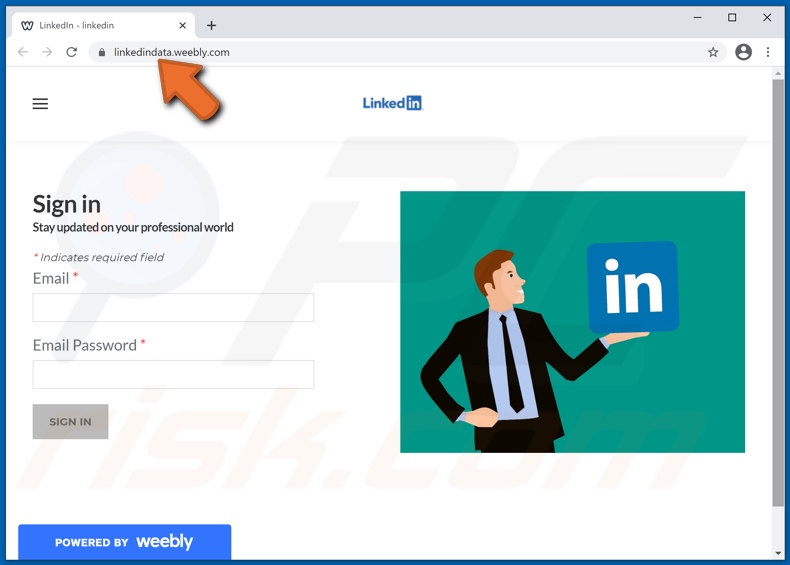
Another example of LinkedIn-themed spam email promoting a phishing site:
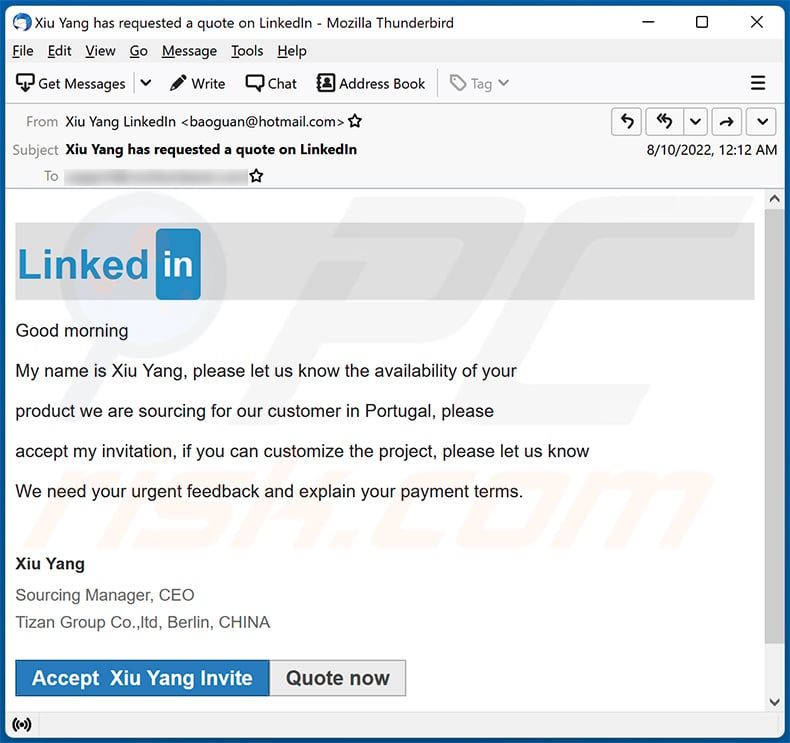
Text presented within:
Subject: Xiu Yang has requested a quote on LinkedIn
Linked in
Good morning
My name is Xiu Yang, please let us know the availability of your
product we are sourcing for our customer in Portugal, please
accept my invitation, if you can customize the project, please let us know
We need your urgent feedback and explain your payment terms.
Xiu Yang
Sourcing Manager, CEO
Tizan Group Co.,ltd, Berlin, CHINA
Accept Xiu Yang Invite
Quote now
Yet another example of LinkedIn-themed spam email promoting a phishing site:
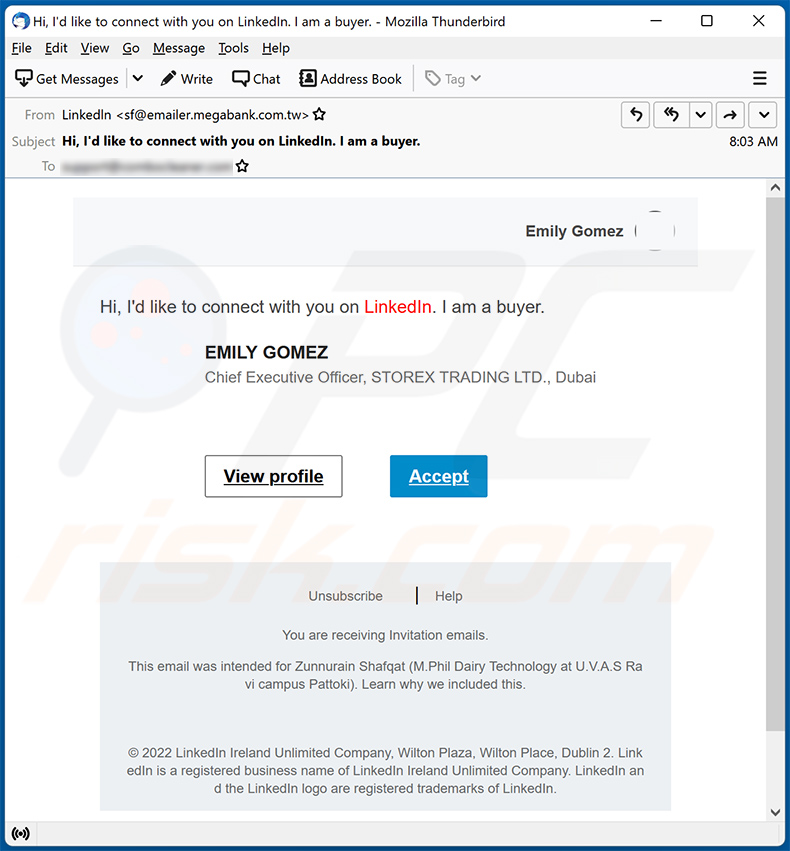
Text presented within:
Subject: Hi, I'd like to connect with you on LinkedIn. I am a buyer.
Emily Gomez
Hi, I'd like to connect with you on LinkedIn. I am a buyer.EMILY GOMEZ
Chief Executive Officer, STOREX TRADING LTD., DubaiAccept
View profileUnsubscribe | Help
You are receiving Invitation emails.
This email was intended for Zunnurain Shafqat (M.Phil Dairy Technology at U.V.A.S Ravi campus Pattoki). Learn why we included this.© 2022 LinkedIn Ireland Unlimited Company, Wilton Plaza, Wilton Place, Dublin 2. LinkedIn is a registered business name of LinkedIn Ireland Unlimited Company. LinkedIn and the LinkedIn logo are registered trademarks of LinkedIn.
Screenshot of the promoted phishing site (ayarepresentaciones[.]com[.]py - fake LinkedIn website):
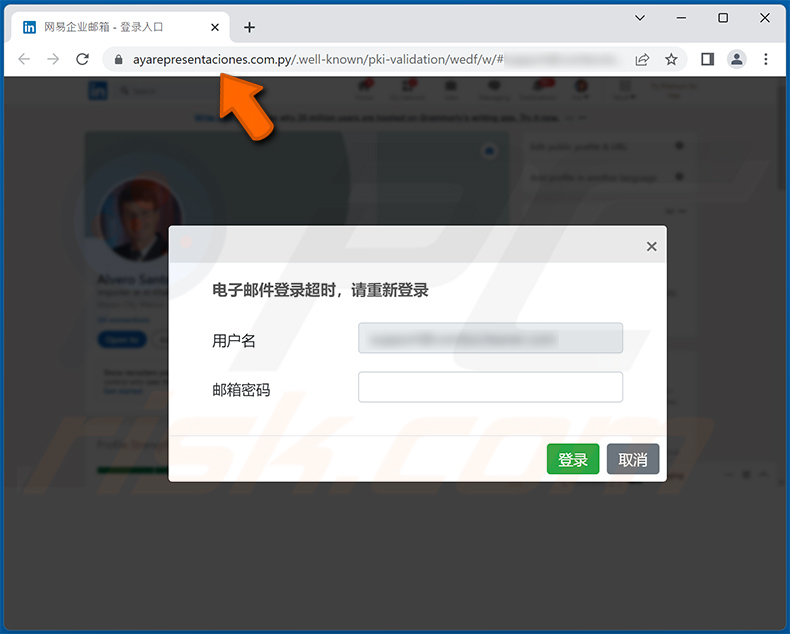
Another example of a LinkedIn-themed spam email:
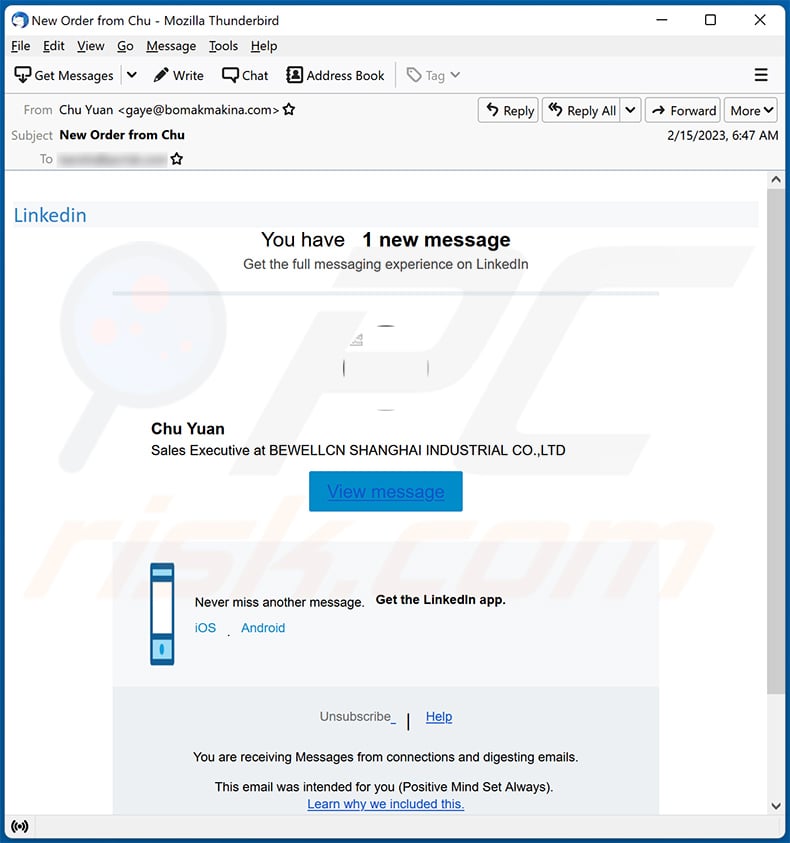
Text presented within:
Subject: New Order from Chu
You have 1 new message
Get the full messaging experience on LinkedIn
Fetzer E. Brian tank
Chu YuanSales Executive at BEWELLCN SHANGHAI INDUSTRIAL CO.,LTD
View message
Mobile phone image
Never miss another message. Get the LinkedIn app.
iOS . Android
Unsubscribe | HelpYou are receiving Messages from connections and digesting emails.
This email was intended for you (Positive Mind Set Always). Learn why we included this.
© 2018 LinkedIn Corporation, 1000 West Maude Avenue, Sunnyvale, CA 94085 . LinkedIn and the LinkedIn logo are registered trademarks of LinkedIn.
Yet another example of an email from LinkedIn spam campaign:
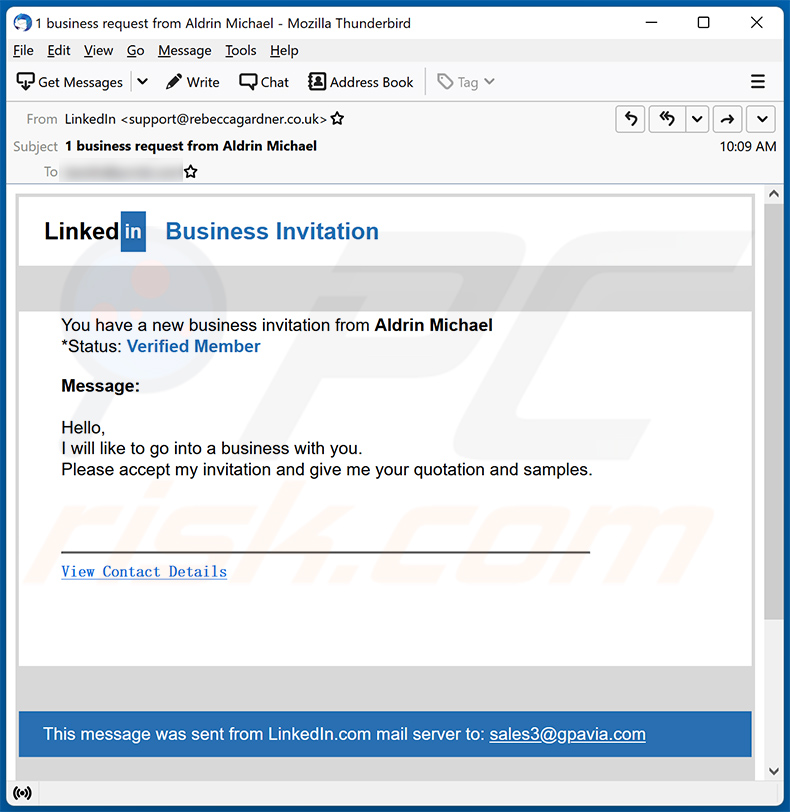
Text presented within:
Subject: 1 business request from Aldrin Michael
Business Invitation
You have a new business invitation from Aldrin Michael
*Status: Verified MemberMessage:
Hello,
I will like to go into a business with you.
Please accept my invitation and give me your quotation and samples.View Contact Details
This message was sent from LinkedIn.com mail server to: sales3@gpavia.com
© 2021 LinkedIn Ireland Unlimited Company, Wilton Plaza, Wilton Place, Dublin 2.
LinkedIn Ireland Unlimited Company
Example of yet another email from LinkedIn-themed spam campaign:
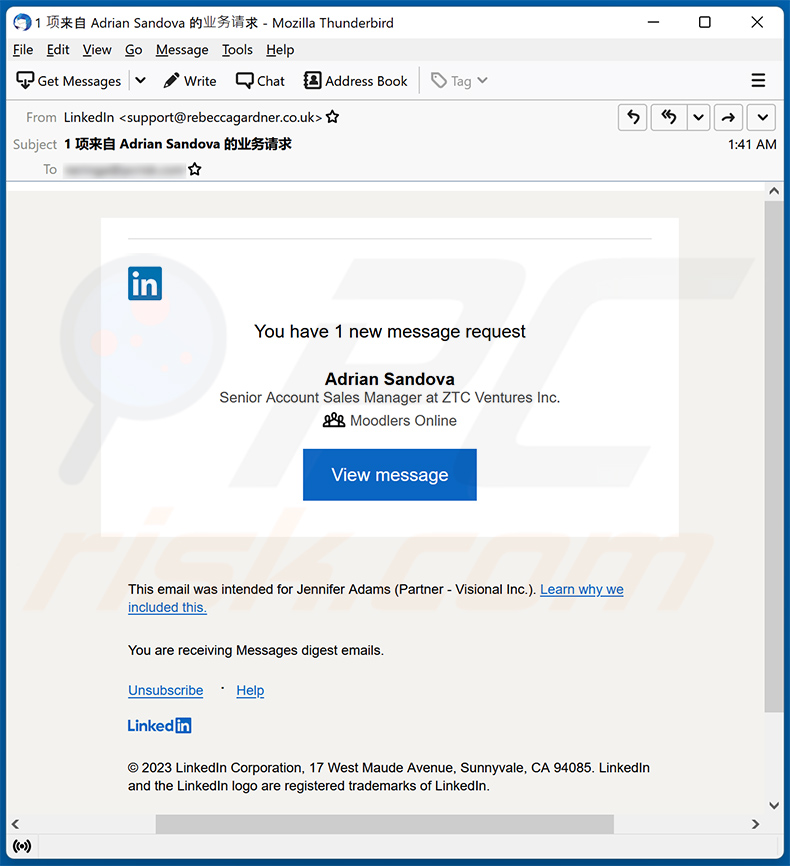
Text presented within:
Subject: 1 项来自 Adrian Sandova 的业务请求
You have 1 new message request
Adrian Sandova
Senior Account Sales Manager at ZTC Ventures Inc.
Moodlers Online
View messageThis email was intended for Jennifer Adams (Partner - Visional Inc.). Learn why we included this.
You are receiving Messages digest emails.
Unsubscribe · Help© 2023 LinkedIn Corporation, 17 West Maude Avenue, Sunnyvale, CA 94085. LinkedIn and the LinkedIn logo are registered trademarks of LinkedIn.
Screenshot of the promoted phishing site:
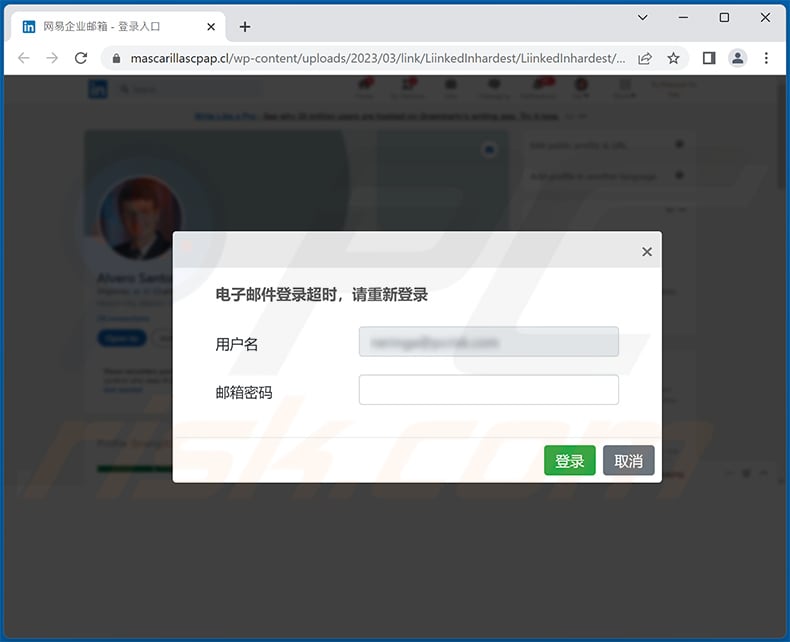
Yet another example of an email from LinkedIn spam campaign:
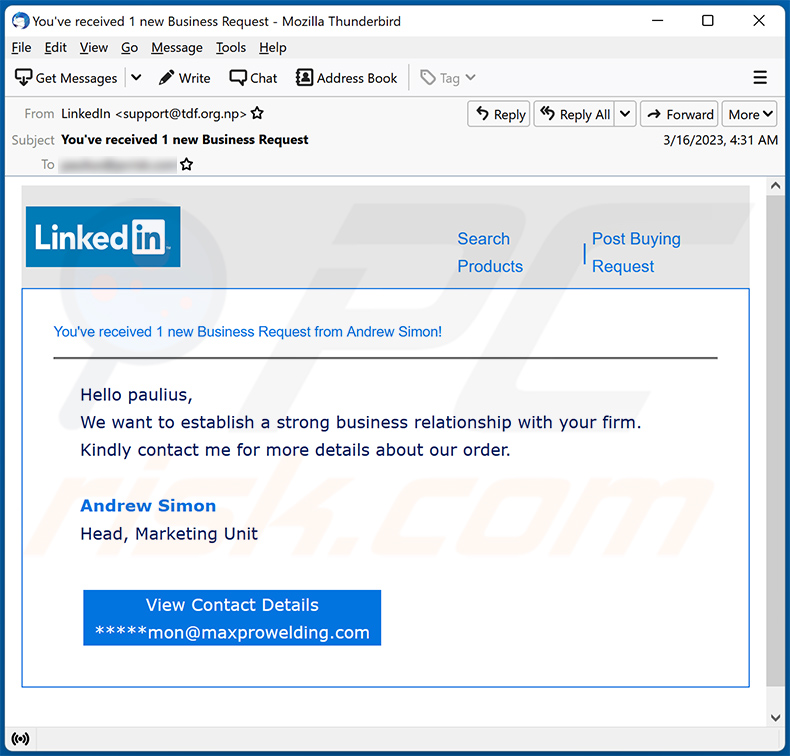
Text presented within:
Subject: You've received 1 new Business Request
Search Products | Post Buying Request
You've received 1 new Business Request from Andrew Simon!
Hello -,
We want to establish a strong business relationship with your firm.
Kindly contact me for more details about our order.Andrew Simon
Head, Marketing Unit
View Contact Details *****mon@maxprowelding.com
Yet another example of an email from "LinkedIn" spam campaign:
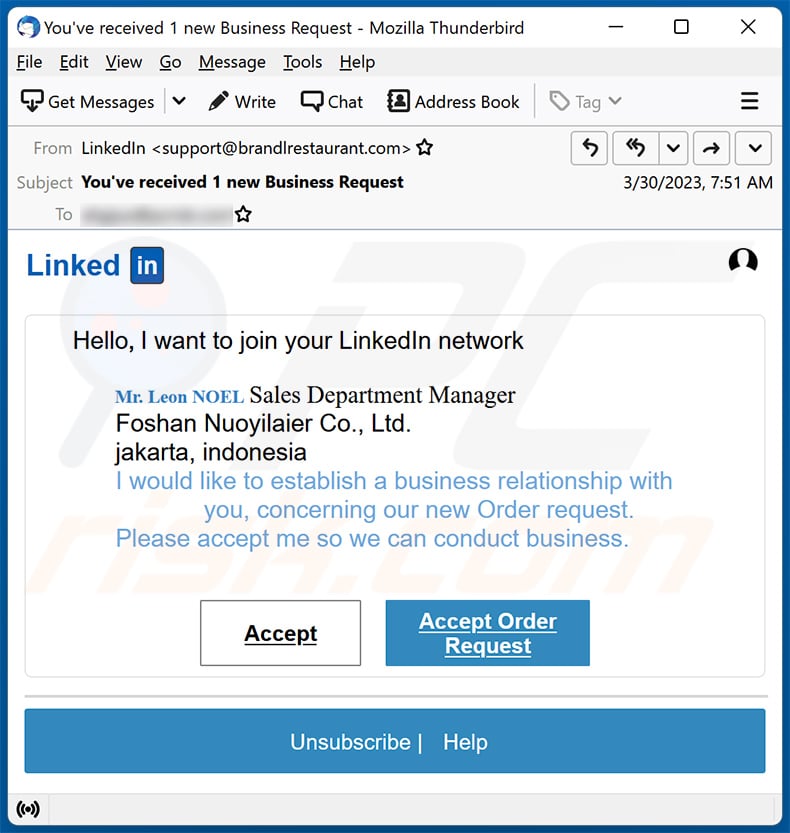
Text presented within:
Subject: You've received 1 new Business Request
Linked in
Hello, I want to join your LinkedIn network
Mr. Leon NOEL Sales Department Manager
Foshan Nuoyilaier Co., Ltd.
jakarta, indonesia
I would like to establish a business relationship with you, concerning our new Order request.
Please accept me so we can conduct business.Accept
Accept Order Request
Unsubscribe | Help
Instant automatic malware removal:
Manual threat removal might be a lengthy and complicated process that requires advanced IT skills. Combo Cleaner is a professional automatic malware removal tool that is recommended to get rid of malware. Download it by clicking the button below:
DOWNLOAD Combo CleanerBy downloading any software listed on this website you agree to our Privacy Policy and Terms of Use. To use full-featured product, you have to purchase a license for Combo Cleaner. 7 days free trial available. Combo Cleaner is owned and operated by RCS LT, the parent company of PCRisk.com.
Quick menu:
- What is LinkedIn spam?
- Types of malicious emails.
- How to spot a malicious email?
- What to do if you fell for an email scam?
Types of malicious emails:
![]() Phishing Emails
Phishing Emails
Most commonly, cybercriminals use deceptive emails to trick Internet users into giving away their sensitive private information, for example, login information for various online services, email accounts, or online banking information.
Such attacks are called phishing. In a phishing attack, cybercriminals usually send an email message with some popular service logo (for example, Microsoft, DHL, Amazon, Netflix), create urgency (wrong shipping address, expired password, etc.), and place a link which they hope their potential victims will click on.
After clicking the link presented in such email message, victims are redirected to a fake website that looks identical or extremely similar to the original one. Victims are then asked to enter their password, credit card details, or some other information that gets stolen by cybercriminals.
![]() Emails with Malicious Attachments
Emails with Malicious Attachments
Another popular attack vector is email spam with malicious attachments that infect users' computers with malware. Malicious attachments usually carry trojans that are capable of stealing passwords, banking information, and other sensitive information.
In such attacks, cybercriminals' main goal is to trick their potential victims into opening an infected email attachment. To achieve this goal, email messages usually talk about recently received invoices, faxes, or voice messages.
If a potential victim falls for the lure and opens the attachment, their computers get infected, and cybercriminals can collect a lot of sensitive information.
While it's a more complicated method to steal personal information (spam filters and antivirus programs usually detect such attempts), if successful, cybercriminals can get a much wider array of data and can collect information for a long period of time.
![]() Sextortion Emails
Sextortion Emails
This is a type of phishing. In this case, users receive an email claiming that a cybercriminal could access the webcam of the potential victim and has a video recording of one's masturbation.
To get rid of the video, victims are asked to pay a ransom (usually using Bitcoin or another cryptocurrency). Nevertheless, all of these claims are false - users who receive such emails should ignore and delete them.
How to spot a malicious email?
While cyber criminals try to make their lure emails look trustworthy, here are some things that you should look for when trying to spot a phishing email:
- Check the sender's ("from") email address: Hover your mouse over the "from" address and check if it's legitimate. For example, if you received an email from Microsoft, be sure to check if the email address is @microsoft.com and not something suspicious like @m1crosoft.com, @microsfot.com, @account-security-noreply.com, etc.
- Check for generic greetings: If the greeting in the email is "Dear user", "Dear @youremail.com", "Dear valued customer", this should raise suspiciousness. Most commonly, companies call you by your name. Lack of this information could signal a phishing attempt.
- Check the links in the email: Hover your mouse over the link presented in the email, if the link that appears seems suspicious, don't click it. For example, if you received an email from Microsoft and the link in the email shows that it will go to firebasestorage.googleapis.com/v0... you shouldn't trust it. It's best not to click any links in the emails but to visit the company website that sent you the email in the first place.
- Don't blindly trust email attachments: Most commonly, legitimate companies will ask you to log in to their website and to view any documents there; if you received an email with an attachment, it's a good idea to scan it with an antivirus application. Infected email attachments are a common attack vector used by cybercriminals.
To minimise the risk of opening phishing and malicious emails we recommend using Combo Cleaner Antivirus for Windows.
Example of a spam email:

What to do if you fell for an email scam?
- If you clicked on a link in a phishing email and entered your password - be sure to change your password as soon as possible. Usually, cybercriminals collect stolen credentials and then sell them to other groups that use them for malicious purposes. If you change your password in a timely manner, there's a chance that criminals won't have enough time to do any damage.
- If you entered your credit card information - contact your bank as soon as possible and explain the situation. There's a good chance that you will need to cancel your compromised credit card and get a new one.
- If you see any signs of identity theft - you should immediately contact the Federal Trade Commission. This institution will collect information about your situation and create a personal recovery plan.
- If you opened a malicious attachment - your computer is probably infected, you should scan it with a reputable antivirus application. For this purpose, we recommend using Combo Cleaner Antivirus for Windows.
- Help other Internet users - report phishing emails to Anti-Phishing Working Group, FBI’s Internet Crime Complaint Center, National Fraud Information Center and U.S. Department of Justice.
Frequently Asked Questions (FAQ)
Why did I receive this email?
Phishing emails are commonly distributed in large quantities to random email addresses, with the aim of deceiving some recipients into revealing personal information. These messages are typically not personalized.
I have provided my personal information when tricked by this email, what should I do?
If you have disclosed any login information, it is crucial that you promptly update all of your passwords.
I have downloaded and opened a file attached to this email, is my computer infected?
If you have downloaded and opened a malicious file attached to an email, your computer may have been infected with malware. By executing the malicious file, the malware can gain access to your system.
I have read the email but didn't open the attachment, is my computer infected?
Simply opening an email does not pose a risk to your system. However, clicking on links or downloading attachments within the email can lead to a system infection.
Will Combo Cleaner remove malware infections that were present in email attachment?
Although Combo Cleaner can identify and eliminate most known malware infections, it is important to keep in mind that advanced malware can hide deep within the system. Therefore, conducting a full system scan is crucial to identifying and removing potential threats.
Share:

Tomas Meskauskas
Expert security researcher, professional malware analyst
I am passionate about computer security and technology. I have an experience of over 10 years working in various companies related to computer technical issue solving and Internet security. I have been working as an author and editor for pcrisk.com since 2010. Follow me on Twitter and LinkedIn to stay informed about the latest online security threats.
PCrisk security portal is brought by a company RCS LT.
Joined forces of security researchers help educate computer users about the latest online security threats. More information about the company RCS LT.
Our malware removal guides are free. However, if you want to support us you can send us a donation.
DonatePCrisk security portal is brought by a company RCS LT.
Joined forces of security researchers help educate computer users about the latest online security threats. More information about the company RCS LT.
Our malware removal guides are free. However, if you want to support us you can send us a donation.
Donate
▼ Show Discussion